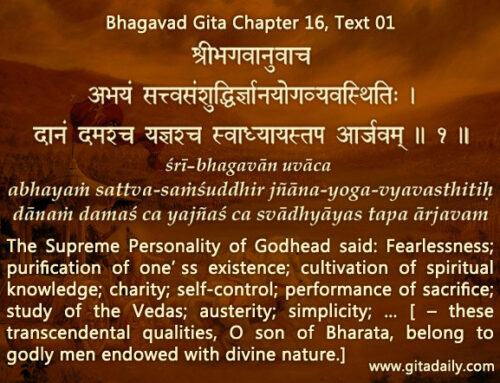Link to purport by A C Bhaktivedanta Swami Srila Prabhupada
Transcript of Bhakti-Shastri class on this verse by Chaitanya Charan
Bg 18.9
kāryam ity eva yat karma
niyataṁ kriyate ’rjuna
saṅgaṁ tyaktvā phalaṁ caiva
sa tyāgaḥ sāttviko mataḥ
Synonyms:
kāryam — it must be done; iti — thus; eva — indeed; yat — which; karma — work; niyatam — prescribed; kriyate— is performed; arjuna — O Arjuna; saṅgam — association; tyaktvā — giving up; phalam — the result; ca — also; eva — certainly; saḥ — that; tyāgaḥ — renunciation; sāttvikaḥ — in the mode of goodness; mataḥ — in My opinion.
Translation:
O Arjuna, when one performs his prescribed duty only because it ought to be done, and renounces all material association and all attachment to the fruit, his renunciation is said to be in the mode of goodness.
kāryam ity eva yat karma, when one understand that this is prescribed duty
niyataṁ kriyate ’rjuna, it is prescribed for him and one does that Arjuna
saṅgaṁ tyaktvā phalaṁ caiva, one gives up material attachment and does the activity.
sa tyāgaḥ sāttviko mataḥ, such tyaga is in the mode of goodness,
So in this way Krishna has endorsed activities in the mode of goodness, tyaga renunciation also in mode of goodness which means action in renunciation and not renunciation from action.
So in this way Arjuna’s question was please explain Sanyasa and Tyaga, so Krishna doesn’t go in hair splitting analysis in both the terms in 18.7 Krishna uses the word Sanyasa as well as Tyaga, Krishna has used these two word in same sloka and if we look at the meanings, Krishna has used the two words interchangeable, He says if one does Sanyas of the Karma, then that is Tyaga in Tamo Guna, that means Sanyasa and Tyaga Krishna used in same way, so instead of hair splitting of the terms Krishna described the broad principle of three modes and answers Arjuna’s question, so how Krishna uses this analysis of Karma Yoga will be discussed in further section.
End of transcription.



Leave A Comment